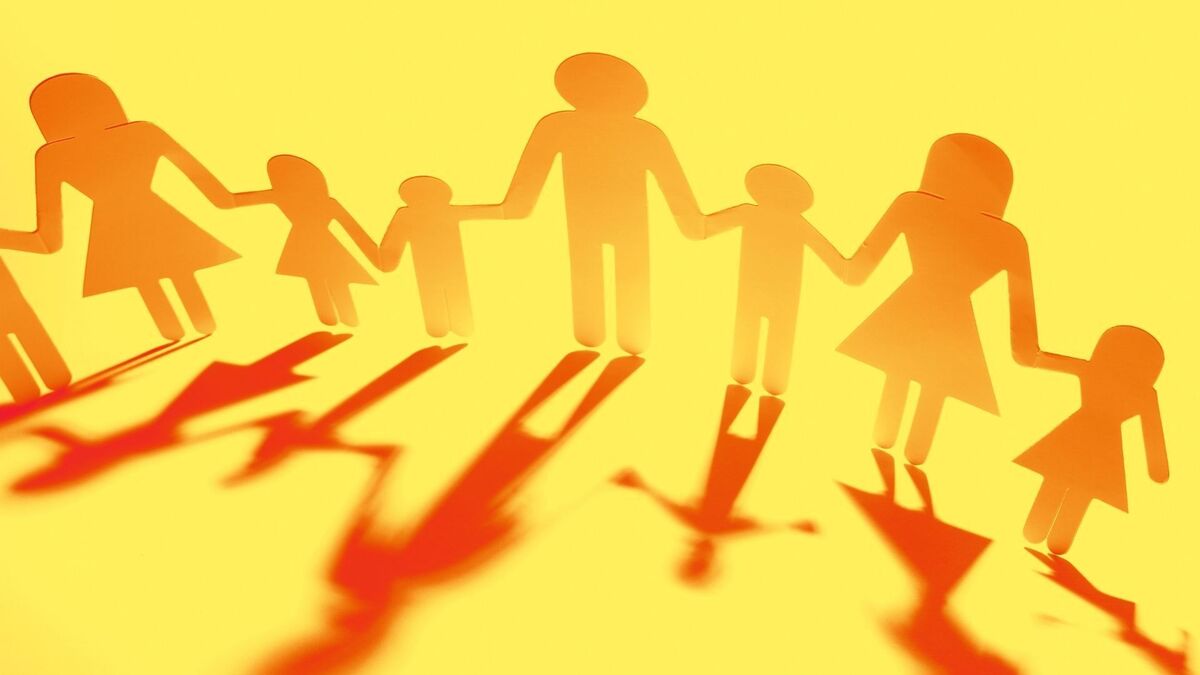Table of contents
Learn all about systemic family constellation!

The Systemic Family Constellation technique can be a fast, effective and beneficial way of resolving family conflicts. Often, the accumulation of hurt and frustration between relatives can end up generating pain and suffering, so that this impacts on other relationships of the people involved in this context.
It is worth remembering, however, that Family Constellation is not a practice recognized by the Federal Council of Psychology or even scientifically proven by the Federal Council of Medicine. Despite this, good results are reported by people who decide to use this alternative.
Throughout the article, we'll go into more detail about what Systemic Family Constellation is, how it works and the benefits it can bring to a person's life. If you want to know more about it, read on.
Understanding more about family constellation

Considered a therapeutic practice, Systemic Family Constellation aims to resolve generational conflicts. As such, it can be done in groups or individually and is related to systemic psychotherapy. It also takes into account certain laws, which will be discussed in detail below. Read on to find out more.
What is family constellation?
Systemic Family Constellation can be considered a therapeutic practice that aims to resolve family conflicts that span several generations. In this way, it has some content that is close to psychodrama due to its dramatization of situations. In addition, it also has intersections with brief psychotherapy due to its rapid action.
It's worth pointing out that this dynamic can be done individually or in a group. Throughout the session, people recreate situations involving feelings provoked in the person being constellated by their family. When we talk about group sessions, volunteers and participants live out the scenes in question. In individual sessions, on the other hand, puppets act out these roles.
Origin and general principles of family constellation
In terms of its origins, it can be said that Family Constellation was first mentioned by Alfred Adler, an Austrian psychiatrist known for his involvement in the individual psychology school of thought. The term was used by the doctor to describe a structure and the role of each family member within it.
This is the Family Constellation model used today and was conceived by the scientist as a combination of various therapeutic techniques and also with a philosophical approach, based on the perception of ideas.
Relationship with systemic psychotherapy
The relationship between Family Constellation and Systemic Psychotherapy is due to the study of similar techniques. Thus, both observe the methods of psychodrama, created by Jacob Levy Moreno. In this technique, theater is used as a tool to compose some scenes brought by the patient himself and his issues are worked on from there.
Another point where the two approaches meet is in the technique of family sculptures, which was first introduced to psychology by Virginia Satir. According to the information we have, this technique would have served as inspiration for the puppets in the individual Family Constellation plays.
The three laws of love in family constellation
According to Bert Hellinger, responsible for developing Systemic Family Constellation as we have it today, there are three laws of love, which are responsible for governing human relationships in general and are established according to different functions in people's lives.
More details on each of these laws will follow, so read on to find out more.
Law of Belonging
The Law of Belonging, also known as Attachment, highlights the need that people have to belong to their family nucleus. In this way, everyone who is born into a family has this right and this includes even those who die prematurely. However, it is very common for some people to be forgotten.
This usually happens when thinking about them can bring pain to the family as a whole, but as long as these people are not properly remembered and acknowledged by the system, it cannot find peace. Furthermore, when one person is forgotten, this generates a need for re-establishment in the others.
Law of Order or Hierarchy
As far as the Law of Order or Hierarchy is concerned, it is worth pointing out that it is established by the order in which people arrive in the family system. In this way, it is thought of in chronological order and this needs to be recognized in order to maintain balance. Therefore, the people who arrived earlier, due to the fact that they have older ties, have greater importance.
Relationships between fathers and mothers, for example, would be stronger than the love between parents and children, and the first children would necessarily have stronger ties to their parents than the others. This, however, is not linked to importance but to precedence in the eyes of Systemic Family Constellation.
Law of Equilibrium
When talking about the Law of Balance, it's interesting to note that the practices of giving and receiving need to have this characteristic according to Family Constellation. In other words, no one can give more and receive less within a family system. Otherwise, this would make some people more active than others, which would undermine exactly the balance.
Therefore, there would always be a debt between people and ideally that can't happen. Retribution must always be present so that bonds can grow and love can flourish in a healthy way.
What is systemic family constellation for?
It's important to note that Systemic Family Constellation's main objective is to make it easier to understand psychological disorders. It works especially with those that can be stimulated by the relationships established between family members, so the sessions can help resolve this type of problem.
It's worth mentioning that the therapy in question is also an important tool for those who are looking to resolve conflicts linked to their most intimate relationships. This is because the technique is able to help them treat negative relationship patterns and overcome their internal conflicts.
When and for whom is family constellation indicated?
Systemic Family Constellation therapy is not suitable for people who are experiencing intense depression. In addition, those who are at a stage of emotional fragility or have some cognitive impairment should not use this technique to resolve their conflicts.
This is because Constellation touches on very deep issues and accesses difficult feelings, so people who have a psychopathological condition or are going through a psychiatric crisis may end up experiencing more harm than good by opting for the technique.
Benefits of family constellation

Applied quickly, Family Constellation is a technique that can bring many benefits to people by helping to identify their deepest issues, thus bringing about changes in their relationship patterns and helping them to develop self-knowledge and self-control.
Find out more about these and other benefits of the practice in the next section of the article.
Causes a change in relationship patterns
Family Constellation helps people marked by traumas, especially subliminal ones related to the family, to be able to modify their relationship patterns, derived from the reproduction of behaviors learned in this system. Thus, by trying to understand the origin of their internal conflicts, the individual ends up being able to resolve them and avoid damaging other relationshipsintimate.
In this way, their balance in this sphere is restored and they become able to make more assertive decisions and show their feelings without feeling so afraid of what people will do to them.
Helps develop self-knowledge and self-control
As Family Constellation involves an in-depth investigation of feelings and events in the life of the person being constellated, it provides greater self-knowledge and helps them to develop self-control, which is beneficial for their behavior in general. After all, a person who doesn't know themselves or know how to contain themselves can harm others.
Therefore, Family Constellation prevents the progression of negative attitudes that are carried out impulsively, without any prior reflection. Gradually, those who undergo this technique experience a change in the way they see their own image and this also reflects positively on their relationships.
Helps to overcome past problems and pain
Problems from the past, especially family problems, can be overcome through Family Constellation. This is because a person who is immersed in this type of situation, when they begin to have the opportunity to open up to other perspectives, ends up realizing that they can break the cycle and overcome the pain.
In this way, ties with the family can be re-established or effectively severed, depending on what the constellated person discovers in the course of their situations. Regardless of the decision made, the bonds have already been corrupted and what united them to the family no longer exists, so the ties need to be seen through different eyes in order to be re-established.
Improves the patient's quality of life
Undoubtedly, family conflicts can have an impact on people's lives as a whole, so being able to understand and resolve them is something that brings significant improvements to patients' lives. In addition to all the points mentioned above, work is also a sector that is positively impacted by Systemic Family Constellation.
This is because the personal growth brought about by the technique helps the constellation member to no longer make derogatory decisions and act as if they don't deserve their achievements, something that undoubtedly affects the way their superiors see them. Therefore, making career-related decisions becomes simpler.
How family constellation works

There are currently three types of Systemic Family Constellation therapy, each with its own distinct techniques, which will be discussed below so that you can get to know the technique better and decide which one best fits your reality and suits your purposes. See below for more details!
Face-to-face therapy with representatives
Face-to-face therapy with representatives is one of the modalities of Systemic Family Constellation. It has seven distinct stages and in the second stage "actors" are chosen to represent the members of the constellatee's family. The ultimate goal is to arrive at an insight that can help resolve the conflicts presented during the first stage.
Each of the phases of face-to-face Family Constellation with representatives will be discussed below. See how the process works in detail.
1st stage: defining the problem
The first stage of Family Constellation consists of defining the problem. Then, the person being constellated needs to tell the constellator what the pain is so that he or she can understand the reasons why he or she felt the help of therapy was necessary. This will serve to guide the sessions.
With this definition, the constellator will be able to start the process by following the techniques that best suit the individual's needs and ensuring that they are able to resolve their conflicts in the best possible way.
2nd stage: choosing representatives
The second stage consists of choosing the representatives. At this point, there is a group session in which some people from the audience are chosen by the constellation to play the roles of their family members. Those chosen will be present in the scenes that are staged in the future.
It's worth pointing out that this stage only takes place in the face-to-face model and with representatives, since in individual face-to-face therapy, dolls or sculptures are used to play this role. In addition, in the second stage, the family members must also be introduced to the constellator as a way of identifying the causes of the trauma.
Stage 3: assembling the constellation
Once the representatives have been duly defined, we move on to the third stage, which consists of setting up the constellation. At this point, the client positions the participants in the space they have available and reflects on the links they have with each of them.
In addition, it is interesting to note that the participants chosen for the constellation take an active role. Faced with the constellatee's explanation of the relationships, they can choose which space they believe fits best in the constellation. However, this must take into account the feelings expressed by the patient.
Stage 4: solution process
Once the constellation has been properly set up, the process of resolving the conflict begins, which in fact consists of a search. Ideas then start to emerge for the constellants, the representatives and the therapists. In this way, the three of them work together to arrive at some insight capable of resolving the problems.
At this point, the action of each of the representatives is fundamental, and without it potential solutions won't begin to take shape. When this stage is nearing its conclusion, a path towards ending the conflict should begin to stand out more clearly.
Stage 5: solution
Once the path has been properly mapped out, the problem-solving phase begins. Then, at the end of the session, the constellation is reassembled, so that the participants assume the positions in which they will be able to bring more balance to the system as a whole. Soon, some new visions can be presented, both by the client and by the chosen representatives and the therapist.
This leads to a new understanding of the situation presented at the beginning, which gives the person being assisted more self-knowledge and self-confidence.
Stage 6: closing phase
Once the family conflict has been resolved, the closing phase of the session begins. This stage consists of the client and the representatives explaining their feelings that have not yet been highlighted. The whole process is closely guided by the therapist.
As the feelings are discussed, the representatives point out to the constellation member how they felt playing the role of that family member and point out how this might affect the constellation member in the future. Then we move on to the last phase of Systemic Family Constellation.
Step 7: Tips for integrating constellations
The seventh and final stage of the Systemic Family Constellation consists of some advice for the constellation to be properly integrated. From this point onwards, the person being constellated must be willing to commit to the interpretation they have obtained during the consultation and act in accordance with what has been indicated.
It is also worth pointing out that depending on the case presented, the patient may have certain actions to take from then on so that family conflicts can be properly resolved. Only with these actions will their more intimate relationships be properly improved.
Face-to-face therapy with puppets
Some people choose not to use proxies in Systemic Family Constellation, so the dolls work as substitutes and serve to represent the members of their family. In this model, it is the constellator himself who proposes where to start based on what he has heard from the patient.
For example, if he perceives some kind of conflict with the father, especially linked to misunderstanding, the doll that serves to represent this family member can be positioned looking in the opposite direction to the son.
Online therapy
Due to the pandemic, many modalities of therapy have ended up resorting to technological resources for continuity and Systemic Family Constellation is no different. Thus, this practice can be done over the internet and takes place through a video call.
For everything to go smoothly, the person being assisted needs to be in a quiet and peaceful place, so that he and the therapist can talk about the movements in his family, seeking the same understanding that is sought in a face-to-face session. In general, these meetings last an hour and the individual's pending issues and needs in his family ties are studied.
Family constellation phrases
Some of Bert Hellinger's phrases are quite common in family constellation sessions. Here are a few of them.
"Only when we are in tune with our destiny, with our parents, with our origin and take our place, do we have the strength."
"Family sufferings are like links in a chain that are repeated from generation to generation until one becomes aware and turns the curse into a blessing."
"A person is at peace when all the people who belong to their family have a place in their heart."
"Money, mother and life are equivalent energies. As we treat mother, so life and money treat us."
Further information about family constellation

Despite the popularity of Systemic Family Constellation, it is still common for many people to have doubts about the practice, especially with regard to how to hold a session and also the effectiveness of the method. Therefore, these and other recurring questions will be discussed in more detail below. Read on to find out more.
What is the role of the family therapist?
In general terms, the role of a family therapist can be described as working out new alternatives so that a particular family can resolve its conflicts, understand its problems and correct past mistakes. In this way, the therapist's role is also to highlight the family's ability to heal itself.
Therefore, the members of the system are placed as active agents and their participation is fundamental for the conflicts to reach a conclusion. It is worth emphasizing that the therapeutic process is different in each case because families have particular dynamics and conflicts.
How to do a family constellation session?
The technique in question is based on subjectivity and empiricism, so it's important to find a professional who has an approach in line with what you're looking for.
Nowadays, there are several clinics dedicated to this type of consultation, where the professionals are properly trained and have a team of well-trained representatives. Therefore, to have a session, it's best to go to these places.
Price and where to have a family constellation session
It's interesting to note that there are currently spaces that specialize in carrying out Systemic Family Constellation and the best way to carry out the technique is to look for one of these places, where the professionals have the appropriate qualifications to carry out the method competently.
When it comes to prices, it's worth pointing out that they can be variable and are dependent on the type of therapy chosen by the person receiving the constellation. Thus, sessions can cost between R$300 and R$1000.
Effectiveness of family constellation sessions
The effectiveness of family constellation sessions depends on how open each individual is to the transformations that the process can promote. Throughout the consultation, the representatives and the constellator can speak a few phrases aimed at systemic healing that have to do with acceptance and setting limits in family relationships.
It is possible to say that the professionals believe that these phrases promote the re-signification of conflicts, hurts and pains. In this way, negative emotions are diluted and give way to a feeling of appeasement.
Negative points of family constellation
The main negative point of Systemic Family Constellation is that it is not recognized by the Federal Council of Psychology or the Federal Council of Medicine as a scientific practice. This is due to the lack of data and studies to support its effectiveness.
It is worth mentioning that even Bert Hellinger pointed out that Family Constellation was not a therapy, but an empirical method. It is based on people's experiences and the observations made by the researcher himself, who uses theories from Systemic Family Psychology and the Family Sculpture technique as a basis.
Enjoy all the benefits of family constellation!

Systemic Family Constellation, regardless of the model chosen by the person being constellated, helps to resolve generational family conflicts. By addressing patients' grievances and negative feelings, researchers are able to help them come to terms with these obstacles, making life more pleasant.
The sessions can take place in a number of different ways and it is very important that the person undergoing the constellation looks for a place they can trust and with professionals who are qualified to carry it out. In addition, those who use Systemic Family Constellation need to be open to the changes proposed by the technique in order to effectively take advantage of its benefits.
In this way, the cosntelado plays an active and fundamental role in the effectiveness of the practice, as do the people chosen to represent their relatives.

